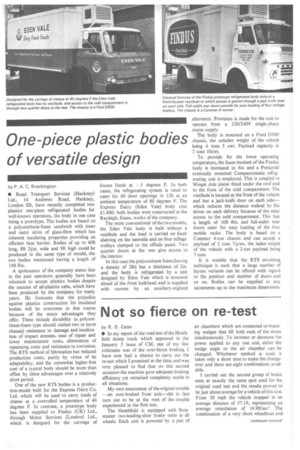Not so fierce on re-test
Page 53

Page 54

If you've noticed an error in this article please click here to report it so we can fix it.
by R. D. Cater
• In my report of the road test of the Heathfield dump truck which appeared in the January 5 issue of CM, one of my few criticisms was of the over-fierce braking. I have now had a chance to carry out the re-test which I promised at the time, and was very pleased to find that on this second occasion the machine gave adequate braking efficiency yet remained completely stable in all situations.
My own assessment of the original trouble —an over-braked front axle—did in fact turn out to be at the root of the trouble experienced in the first test.
The Heathfield is equipped with Stopmaster two-leading-shoe brake units at all wheels. Each unit is powered by a pair of air chambers which are connected to bisecting wedges that lift both ends of the shoes simultaneously. To increase or decrease the power applied to any one unit, either the wedge angle or the air chamber can be changed. Whichever method is used, it takes only a short time to make the changeover and there are eight combinations available.
I carried out the second group of brake tests at exactly the same spot used for the original road test and the results proved to be just about average for a vehicle of this size. From 30 mph the vehicle stopped in an average distance of 57.1ft, representing an average retardation of 16.9ft/see. The combination of a very short wheelbase and rubber suspension caused the vehicle to give a pronounced pitch each time it came to a halt, causing the Tapley meter to jump right off the scale.
From 20 mph the average stopping distance was 26.25ft, representing 16.5ft/see; again, the Tapley readings were thrown out, the lowest recorded being 68 per cent and the highest over 100. The parking brake, powered by spring chambers and acting on the rear wheels only, produced 21 per cent efficiency.
The main brake circuit was then disconnected to evaluate the secondary system, which operates one diaphragm chamber at each wheel, but still powers both the shoes in each unit. Average stopping distance recorded from 20 mph in this condition was 27.75ft or 15.7ft/see; the Tapley recorded 55 per cent.
Because the spring brakes are held off by the pressure in a pipeline linked to both main and secondary circuits, when either one fails the parking brake comes on after 1 or 2 applications of the footbrake. This prevents the driver from continuing.
Since automatic adjusters keep the Stopmaster brakes in correct adjustment at all times, it can safely be assumed that these results would be obtained consistently.
A fade test was carried out by driving the vehicle at full throttle for 0.8 miles with the brakes applied sufficiently to keep the speed down to 20 mph; a crash stop from 20 mph at the end of this section produced a free-set Tapley meter reading of 97 per cent.! certainly had the feeling that 'there would be no fade problems with this model.




































































































































